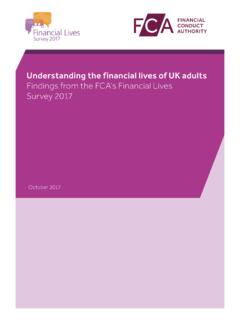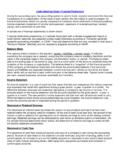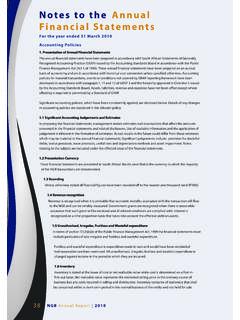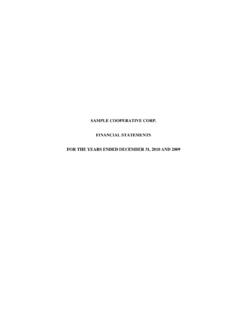Transcription of Impairment of financial instruments under IFRS 9 - …
1 Applying IFRSI mpairment of financial instruments under ifrs 9 December 2014 December 2014 Impairment of financial instruments under ifrs 9 1 Contents In this issue: 1. Introduction .. 4 Brief history and background of the Impairment project .. 4 Overview of ifrs 9 Impairment requirements .. 7 Key changes from the IAS 39 Impairment requirements and the impact and implications .. 8 Key differences from the FASB s proposals .. 10 2. Scope .. 11 3. Approaches .. 12 General approach .. 12 Simplified approach .. 14 Purchased or originated credit-impaired financial assets .. 15 4.
2 Measurement of expected credit losses .. 17 Lifetime expected credit losses .. 17 12-month expected credit losses .. 18 Expected life versus contractual period .. 21 Probability-weighted outcome .. 22 Time value of money .. 22 Collateral .. 24 Reasonable and supportable information .. 25 Interaction between Impairment and fair value hedge accounting .. 29 5. General approach: determining significant increases in credit risk .. 30 Change in the risk of a default occurring .. 31 Factors or indicators of changes in credit risk.
3 33 What is significant? .. 39 Low credit risk operational simplification .. 40 Past due status and more than 30 days past due rebuttable presumption .. 47 12-month risk as an approximation for change in lifetime risk .. 48 Assessment at the counterparty level .. 49 Determining maximum initial credit risk for a portfolio .. 50 2 December 2014 Impairment of financial instruments under ifrs 9 Collective assessment .. 51 Loss rate approach .. 60 6. Modified financial assets .. 61 7. financial assets measured at fair value through other comprehensive income (FVOCI).
4 64 8. Trade receivables, contract assets and lease receivables .. 67 Trade receivables and contract assets .. 67 Lease receivables .. 69 9. Loan commitments and financial guarantee contracts .. 70 10. Revolving credit facilities .. 72 11. Presentation of expected credit losses in the statement of financial position .. 76 Allowance for financial assets measured at amortised cost, contract assets and lease receivables .. 76 Provisions for loan commitments and financial guarantee contracts .. 77 Accumulated Impairment amount for debt instruments measured at fair value through other comprehensive income.
5 77 Trade date and settlement date accounting .. 77 12. Disclosures .. 79 Scope and objectives .. 79 Credit risk management practices .. 80 Quantitative and qualitative information about amounts arising from expected credit losses .. 81 Credit risk exposure .. 85 Collateral and other credit enhancements obtained .. 87 13. Effective date and transition .. 88 Effective date .. 88 Transition (retrospective application) .. 89 Transition reliefs .. 89 Appendix 1: Interaction between the fair value through other comprehensive income measurement category and foreign currency denomination, fair value hedge accounting and Impairment .
6 92 3 December 2014 Impairment of financial instruments under ifrs 9 What you need to know The Impairment requirements in the new standard, ifrs 9 financial instruments , are based on an expected credit loss model and replace the IAS 39 financial instruments : Recognition and Measurement incurred loss model. The expected credit loss model applies to debt instruments recorded at amortised cost or at fair value through other comprehensive income, such as loans, debt securities and trade receivables, lease receivables and most loan commitments and financial guarantee contracts. Entities are required to recognise an allowance for either 12-month or lifetime expected credit losses (ECLs), depending on whether there has been a significant increase in credit risk since initial recognition.
7 The measurement of ECLs reflects a probability-weighted outcome, the time value of money and the best available forward-looking information. The need to incorporate forward-looking information means that application of the standard will require considerable judgement as to how changes in macroeconomic factors will affect ECLs. The increased level of judgement required in making the expected credit loss calculation may also mean that it will be more difficult to compare the reported results of different entities. However, entities are required to explain their inputs, assumptions and techniques used in estimating the ECL requirements, which should provide greater transparency over entities credit risk and provisioning processes.
8 The need to assess whether there has been a significant increase in credit risk will also require new data and processes and the exercise of judgement. The effect of the new requirements will be to require larger loss allowances for banks and similar financial institutions and for investors in debt securities. On transition, this will reduce equity and have an impact on regulatory capital. The level of allowances will also be more volatile in future, as forecasts change. Adopting the expected credit losses requirements will require many entities to make significant changes to their current systems and processes; early impact assessment and planning will be key to managing successful implementation.
9 The ECL Impairment requirements must be adopted with the other ifrs 9 requirements from 1 January 2018, with early application permitted. 4 December 2014 Impairment of financial instruments under ifrs 9 1. Introduction In July 2014, the International Accounting Standards Board (IASB) issued the final version of ifrs 9 financial instruments ( ifrs 9, or the standard), bringing together the classification and measurement, Impairment and hedge accounting phases of the IASB s project to replace IAS 39 and all previous versions of ifrs 9. The IASB has sought to address a key concern that arose as a result of the financial crisis, that the incurred loss model in IAS 39 contributed to the delayed recognition of credit losses.
10 As such, it has introduced a forward-looking expected credit loss model. The ECL requirements and application guidance in the standard are accompanied by 14 Illustrative Examples. This publication discusses the new expected credit loss model as set out in the final version of ifrs 9 and also describes the new credit risk disclosures in relation to the expected credit loss model, as set out in ifrs 7 financial instruments : Disclosures (see section 12 below). Brief history and background of the Impairment project During the financial crisis, the delayed recognition of credit losses that are associated with loans and other financial instruments was identified as a weakness in existing accounting standards.
















